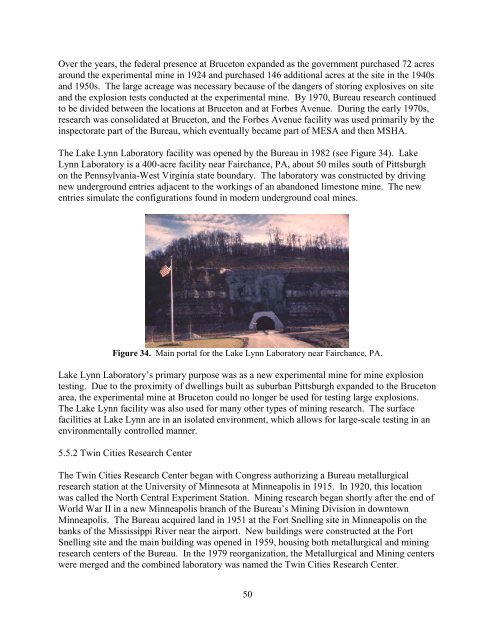One Hundred Years of Federal Mining Safety and Health Research
One Hundred Years of Federal Mining Safety and Health Research
One Hundred Years of Federal Mining Safety and Health Research
- No tags were found...
Create successful ePaper yourself
Turn your PDF publications into a flip-book with our unique Google optimized e-Paper software.
Over the years, the federal presence at Bruceton exp<strong>and</strong>ed as the government purchased 72 acres<br />
around the experimental mine in 1924 <strong>and</strong> purchased 146 additional acres at the site in the 1940s<br />
<strong>and</strong> 1950s. The large acreage was necessary because <strong>of</strong> the dangers <strong>of</strong> storing explosives on site<br />
<strong>and</strong> the explosion tests conducted at the experimental mine. By 1970, Bureau research continued<br />
to be divided between the locations at Bruceton <strong>and</strong> at Forbes Avenue. During the early 1970s,<br />
research was consolidated at Bruceton, <strong>and</strong> the Forbes Avenue facility was used primarily by the<br />
inspectorate part <strong>of</strong> the Bureau, which eventually became part <strong>of</strong> MESA <strong>and</strong> then MSHA.<br />
The Lake Lynn Laboratory facility was opened by the Bureau in 1982 (see Figure 34). Lake<br />
Lynn Laboratory is a 400-acre facility near Fairchance, PA, about 50 miles south <strong>of</strong> Pittsburgh<br />
on the Pennsylvania-West Virginia state boundary. The laboratory was constructed by driving<br />
new underground entries adjacent to the workings <strong>of</strong> an ab<strong>and</strong>oned limestone mine. The new<br />
entries simulate the configurations found in modern underground coal mines.<br />
Figure 34. Main portal for the Lake Lynn Laboratory near Fairchance, PA.<br />
Lake Lynn Laboratory’s primary purpose was as a new experimental mine for mine explosion<br />
testing. Due to the proximity <strong>of</strong> dwellings built as suburban Pittsburgh exp<strong>and</strong>ed to the Bruceton<br />
area, the experimental mine at Bruceton could no longer be used for testing large explosions.<br />
The Lake Lynn facility was also used for many other types <strong>of</strong> mining research. The surface<br />
facilities at Lake Lynn are in an isolated environment, which allows for large-scale testing in an<br />
environmentally controlled manner.<br />
5.5.2 Twin Cities <strong>Research</strong> Center<br />
The Twin Cities <strong>Research</strong> Center began with Congress authorizing a Bureau metallurgical<br />
research station at the University <strong>of</strong> Minnesota at Minneapolis in 1915. In 1920, this location<br />
was called the North Central Experiment Station. <strong>Mining</strong> research began shortly after the end <strong>of</strong><br />
World War II in a new Minneapolis branch <strong>of</strong> the Bureau’s <strong>Mining</strong> Division in downtown<br />
Minneapolis. The Bureau acquired l<strong>and</strong> in 1951 at the Fort Snelling site in Minneapolis on the<br />
banks <strong>of</strong> the Mississippi River near the airport. New buildings were constructed at the Fort<br />
Snelling site <strong>and</strong> the main building was opened in 1959, housing both metallurgical <strong>and</strong> mining<br />
research centers <strong>of</strong> the Bureau. In the 1979 reorganization, the Metallurgical <strong>and</strong> <strong>Mining</strong> centers<br />
were merged <strong>and</strong> the combined laboratory was named the Twin Cities <strong>Research</strong> Center.<br />
50
















